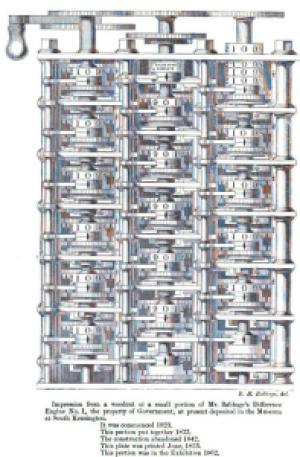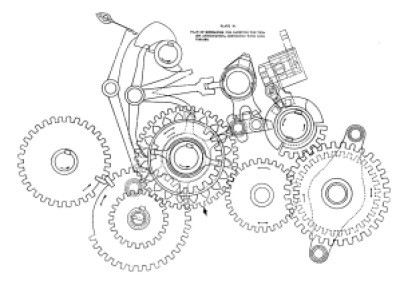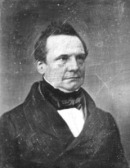We continue the “Machine Philosophy” series with Schaffer’s examination in two essays of the work and thought of mathematician Charles Babbage (1791–1871):
1) “Babbage’s Intelligence: Calculating Engines and the Factory System,” Critical Inquiry 21 (1994): 203-227. [BI]
2) “Babbage’s Dancer and the Impresarios of Mechanism,” in Cultural Babbage: Technology, Time and Invention, edited by Francis Spufford and Jenny Uglow (London and Boston: Faber and Faber, 1996). Reproduced here. [BD]
 From Charles Babbage, Passages from the Life of a Philosopher (1864)
From Charles Babbage, Passages from the Life of a Philosopher (1864)
These essays were published early on in Schaffer’s concern with “machine philosophy,” but they depict the chronological culmination of that philosophy’s ideological potential. In Schaffer’s telling, Babbage’s “lifelong campaign for the rationalization of the world” (BD, 53) was manifested in 1) his mechanization of not simply physical, but mental labor through his calculating engines; 2) his thinking concerning the factory system of manufactures, which, by the time he worked, was deep into its ascendancy in the British economy; and 3) his “Ninth Bridgewater Treatise” on the nature of God and miracles.
Much as Schaffer exploited an ambiguity in the meaning of the term “hands” (meaning the body’s hands as well as hired workmen) to bracket the beginning of machine philosophy, he exploits ambiguity in the meaning of “intelligence” to bracket its culmination.
Most clearly, Babbage’s Difference Engine, which he worked on from 1823 to 1842, was an ambitious attempt to discern the workings of intelligence, as manifested in the act of calculation, and to reduce it to a series of routines, which could be mechanized and so made speedy and reliable. Babbage’s later, more ambitious Analytical Engine carried this project still further. And, according to Schaffer, “The crucial aspects of the new Analytical Engine, its capacity for memory and anticipation, were profound resources for Babbage’s metaphysics and his political economy” (BI, 207).
 Mechanism from Babbage’s Analytical Engine for carrying the tens by anticipation
Mechanism from Babbage’s Analytical Engine for carrying the tens by anticipation
Babbage’s key work on the factory system, On the Economy of Machinery and Manufactures, was published in 1832. In it, he recounted how labor could be analyzed and organized so as to achieve the maximum of efficiency from the manufacturing process. Schaffer quotes Babbage on what later became known as the “Babbage principle” (BI, 209):
The master manufacturer, by dividing the work to be executed into different processes, each requiring different degrees of skill or of force, can purchase exactly that precise quantity of both which is necessary for each process; whereas if the whole work were executed by one workman, that person must possess sufficient skill to perform the most difficult, and sufficient strength to execute the most laborious, of the operations into which the art is divided.
The second meaning of “intelligence,” the knowledge gained through surveillance of the labor market and the factory, allowed the organizers of that system to orchestrate it to their best advantage, making its workings appear to have intelligence, even as it deprived its inhabitants of the privilege of exercising theirs. Schaffer argues for the clear connection between Babbage’s work on the Difference Engine and his political economy (BI, 210):
Babbage’s political strategies of the strife-ridden decade of the 1830s outline a crucial role for the analytic manager. The machinery of the factory and the calculating engines precisely embodied the intelligence of theory and abrogated the individual intelligence of the worker. Only the superior combination and correlation of each component guaranteed the efficient, economical, planned, and therefore intelligent performance. This abstract, lawlike behavior was only visible to the overseer—men such as Babbage…. [T]he new class of managerial analysts [styled themselves] the supreme economic managers and legislators of social welfare. In good Bonapartist style Babbage thought they should be rewarded with newfangled life peerages and political power. The science of calculation became the supreme legislative discipline, just as the calculating engines provided both legislative and executive coordination.
Schaffer further argues that Babbage’s conceptions of political economy shaped, and ultimately derailed, his work on the Difference Engine. According to Schaffer, “The rights of the workers to the whole value of their labour informed much of the radical protest of these key years. Who should ‘own’ these machines? Whose labour did they embody?” (BI, 213) Writing to the Duke of Wellington in 1834, Babbage made his own views clear concerning who should benefit from his engine:
My right to dispose, as I will, of such inventions cannot be contested; it is more sacred in its nature than any hereditary or acquired property, for they are absolute creations of my own mind.
But, Schaffer argues, the Difference Engine clearly was not. Work on it depended critically on the abilities of skilled and innovative craftsmen, particularly the master engineer on the project, Joseph Clement (1779–1844). To function, Babbage’s design required cutting-edge skill in machining, and the development of new mechanical techniques. Workers with experience on the project found themselves able to command high wages, and Babbage and Clement clashed frequently over compensation, control over the work, and Clement’s right to profit by making additional engines. Clement eventually left the project, dealing it a blow that ultimately proved fatal.
For Schaffer, these conflicts were not simply an inability of individuals to come to terms—they represented nothing less than an open clash between ideological systems of science and skilled labor, which, he feels, can be discerned in comments such as those found in a report on the project (BI, 215):
An 1829 Royal Society report on the engine plans conceded that ‘in all those parts of the Machine where the nicest precision is required, the wheelwork only brings them by a first approximation (though a very nice one), to their destined places: they are then settled into accurate adjustment by peculiar contrivances, which admit of no shake or latitude of any kind’.
Schaffer reads the statement through a deeply politicized lens:
The troublesome terms in these bland remarks by the gentlemen of science were the references to nice precision, accurate adjustment, and shake or latitude. What might seem to a savant matters of irrational judgment were the key aspects of the customary culture of the workshop. What might seem to the Royal Society and the Treasury to be worthless or exorbitant demands from the workshop staff would appear within the machine shop as legitimate and self-evident expectations of machinists’ status. The fights between Clement and Babbage which raged between 1822 and 1834 testified to the fury and significance of these issues of control.
I am not convinced by Schaffer’s reading of Babbage’s intransigence into the general mentality of “the wardens of scientific reason” (BI, 204), who, in turn, are aligned with British capitalist interests in a constant struggle with labor, and skilled labor in particular. The case seems even more unlikely when we note that, for Schaffer, this constitutes the culmination of a century-long project, constituting and interlinking a heterogeneous set of developments, which he collectively dubs machine philosophy.
 Babbage
Babbage
Schaffer does, however, make a compelling case for a unity in Babbage’s thought, which is grounded in Babbage’s belief in knowing the world by decomposing it into constituent components, and his belief that the world is best governed by elites capable of arranging those components into newly productive orders. Schaffer suggests the central significance of machinery in Babbage’s throught primarily through two points of evidence, one emblematic, the other philosophical.
First, Schaffer notes that Babbage, as a schoolboy, was shown by automaton maker John Merlin (1735–1803), “two uncovered female figures of silver, about twelve inches high,” one of which was, in Babbage’s words, “an admirable danseuse.” In Schaffer’s words, “Babbage was completely seduced” (BD, 55). Later, in 1834, Babbage acquired the automaton dancer, clothed her, and put her on display in his home in Marylebone, London, in a room adjacent to an unfinished portion of the Difference Engine.
As taken with the dancer automaton as he was, Babbage regarded the Difference Engine as the more profound achievement. Thus, the dancer “provided Babbage with the chance to teach a portentious moral about the decline of the industrial spirit of England. ‘A gay but by no means unintellectual crowd’ of English guests could all too easily be entertained by the dancer’s ‘fascinating and graceful movements’. Only sterner Dutch and American inquirers would bother to visit the Difference Engine next door. Babbage ever after used the divergence to teach his audience about the sinister contrast between foreign seriousness and domestic triviality, between the easy charms of the silver dancer and the demanding challenges of the calculating engine” (BD, 58).
Babbage’s belief in the profundity of the intelligence embodied in his Difference Engine was reflected in his “Ninth Bridgewater Treatise” of 1837.
As prominent works of “natural theology,” the Bridgewater Treatises sought to illustrate for broad, educated audiences how the existence and nature of God could be discerned in the physical universe. In his Third Bridgewater Treatise, first published in 1833, conservative Cambridge philosopher William Whewell (1794–1866) argued that adherents to the “mathematical” or “mechanical philosophy” could not, due to the deductive nature of their enterprise, progress scientific knowledge.
According to Schaffer, Babbage’s “machine philosophy was here assailed from a perspective in complete contrast to that of the radical artisans” (BI, 224). Where the artisans resisted elite attempts to control work by virtue of their privileged knowledge, Whewell challenged the basis of Babbage’s ability to claim to hold such knowledge.
Babbage responded by conceiving of the apparently miraculous not as a spontaneous intervention, but as a consequence of humans’ incomplete knowledge of the divine order. A machine, such as his Difference Engine, might print a series of numbers in an apparent pattern, only to deviate from it, according to the workings of a mechanism previously unperceived by uninformed observers.*
As Schaffer puts it (BI, 226):
In answer to Whewell’s boast that only induction might reveal the divine plan of the world and that machine analysis could never do so, Babbage countered that the world could be perceived as an automatic array only visible as a system from the point of view of its manager. The world system was a macroscopic version of a factory, the philosophy of machinery was the true path to faith, and the calculating engines’ power of ‘volition and thought’ revealed to all.
Babbage had done nothing less than conceive of God in his own image. For Schaffer, Babbage’s vision of the universe and its creator was emblematic of the larger, intimate connections between scientific knowledge and society that had come to characterize the dawn of the modern order: “The systematic gaze was designed to produce the rational order it purported to discover” (BI, 226).
—
*Thony Christie, by the way, has recently posted about Babbage’s position on miracles at The Renaissance Mathematicus.